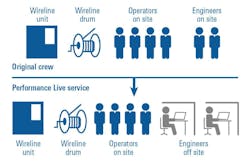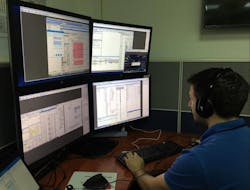Remote operations evolve to offshore industry challenges
The offshore oil and gas industry is facing unprecedented challenges due to the increased market volatility and the COVID-19 pandemic.
The HSE threat from the virus has forced offshore operators to re-think how they staff their rigs. At the same time, operators are working with tighter budgets while facing rising pressure from investors to generate better returns. In addition, growing social consciousness for the environment as well as regulatory changes are having a greater impact on operational decision making. As a result, a growing number of offshore operators are turning to remote operations solutions to not only protect the health and safety of their employees but also to help minimize spending, increase efficiencies and reduce carbon footprint.
Prior to the pandemic, many offshore operators had already adopted remote operations solutions to improve their efficiencies and consistency. But to some, these solutions were considered mostly a nice-to-have; now they are critical to ensuring operational continuity.
Schlumberger has been actively involved in remote operations for more than 20 years. In the late 2000s, the company introduced its operations support centers (OSCs) that enabled real-time monitoring of field activity, representing a significant step change for the industry.
Since then, remote operations solutions have been steadily evolving into increasingly digitally connected solutions. In the field, this evolution has been driven by developing new technologies, from downhole tools to surface system hardware and software, as well as designing new processes and building a robust infrastructure to enable rapid and scalable deployment. These elements, together with advancements in the usage of ever-increasing volumes of data, and the ability of our industry to manage and leverage that data; automation for optimizing workflows; and edge intelligence capabilities, have transformed current operating models.
Today, remote operation solutions have evolved to the point where certain personnel who were once needed on the rig can now do their jobs remotely. In addition to the obvious HSE advantages, cost efficiencies and sustainability benefits are also realized through eliminating or reducing CO2 emissions related to personnel transport logistics and on-site energy consumption.
But these solutions also have another role to play: enabling E&P companies to insulate their operations from a volatile market.
By leveraging new and emerging digital technologies for remote operations, operators can achieve optimal efficiencies consistently and throughout the life of their asset. As the threat of the virus subsides, the lasting benefits realized through recent adoption of digitally connected remote operations solutions are certain to have a lasting and significant impact on our industry.
Remote control
Recently, Schlumberger introduced the Performance Live digitally connected service that enables live control of wellsite operations without engineers on location. The service includes technology and domain expertise within a digital ecosystem, leveraging cloud-based applications and automated data workflows through a secure and robust data network.
The service provides operators with instant access to data and collaboration with multidomain experts via digital network linking centers spanning the globe. This opens any job to borderless competency management for improved operational flexibility as well as faster, more informed decision making for directional drilling, well logging, formation testing and other offshore oil and gas operations.
The service decouples manual and analytical tasks, enabling engineers to focus on the former, working directly with domain experts to optimize job execution. This, combined with automated end-to-end workflows, minimizes redundancy and tedious manual tasks, thus delivering much more consistent service delivery.
In addition, the service increases operational safety and reduces carbon footprint with less travel and fewer personnel needed. While a fully manned rig can have engineer crews of more than 10 people, a wellsite using the digitally connected service operates near autonomously with crews of two or less, depending on the deployed technology. In 2019, 27,000 drilling and measurement and wireline runs were completed using the service.
Operational continuity
Even though the service had been deployed before the COVID-19 pandemic began, within two months, worldwide use of the service expanded by 20%.
So far in 2020, the service has been adopted in over 84 countries. More than 5,000 directional drilling experts averted travel to hundreds of rigs daily. From March to August, service engineers covered more than 50,000 shifts—for drilling and measurement activity—and 4,409 wireline runs, avoiding travel by more than 1,000 people. In June 2020, the service was used to complete 80% of drilling and measurements and wireline operations in one of the countries in the Middle East, setting the industry record for highest remote operation coverage.
Optimizing well evaluations
The service has proven effective for offshore remote logging operations for well integrity evaluation. For example, Aker BP needed to evaluate the cement and casing condition in more than 50 deepwater wells before making decisions regarding P&A, side track, and well intervention operations. Due to the high number of wells requiring well integrity operations, Aker BP needed a cost-effective and reliable solution that would meet all logging objectives.
The digitally connected service, which is supported by a robust high-speed 4G system, completed well integrity logging operations across 53 wells in 2019. The logging was done remotely by a group of experienced wireline engineers with average seniority of nine years and expertise in well integrity and intervention operations. The service included certifying local wellsite supervisors, with an emphasis on wench driving, HSE leadership, and connectivity setup and troubleshooting.
Using the service enabled improved collaboration between the operator and domain experts to quality check, process and interpret data for faster decision making. It also reduced crew size from six to four for each job, cutting mobilization and standby costs.
Furthermore, the operator plans to use the service’s delivery model, along with multiskilled wireline and slickline crew, for future well operations.
Mitigating rig downtime
An operator was drilling an ultraextended-reach drilling (ERD) well when the drill bit got stuck at 10,000 m (32,808.2 ft). Despite multiple attempts to work the pipe, the bit remained stuck and therefore, a wireline pipe recovery service had to be mobilized. The tortuous well trajectory added complexity to the pipe recovery operation, requiring advanced wireline tractors to deploy the pipe severing tools. The operation was expected to take more than seven days with double the crew to cover the 24/7 operation. Due to the ongoing COVID-19 travel restrictions, it was not possible to mobilize the second crew.
The digitally connected service enabled continuous 24/7 operation that was completed in 12 days with only a single crew at the wellsite. The Performance Live service engineer became the second engineer, operating from town. This helped prevent seven days of potential rig downtime due to personnel travel restriction. The service also facilitated collaboration between the wellsite, the operator, the wireline team, the service team, and the global intervention experts in Houston and Paris. As a result, an ultradeep pipe recovery at over 10,000 m was completed successfully and safely, preventing the operator from having to drill a completely new well.
Conclusion
Digitally connected solutions for remote operations can help operators achieve their performance objectives to meet some of the industry’s most pressing challenges.
With the ability for operators and engineers to have live control over critical functions remotely, the wellsite’s associated HSE and process risks are alleviated.
As we move forward from the current challenges brought on by COVID-19, the offshore industry will need to embrace the technology solutions that enable us to do more away from the rig. Remote access to wellsite operations, data, and global domain experts will be more important than ever for E&P companies to achieve highly efficient, sustainable operations that help insulate them from market volatility.




